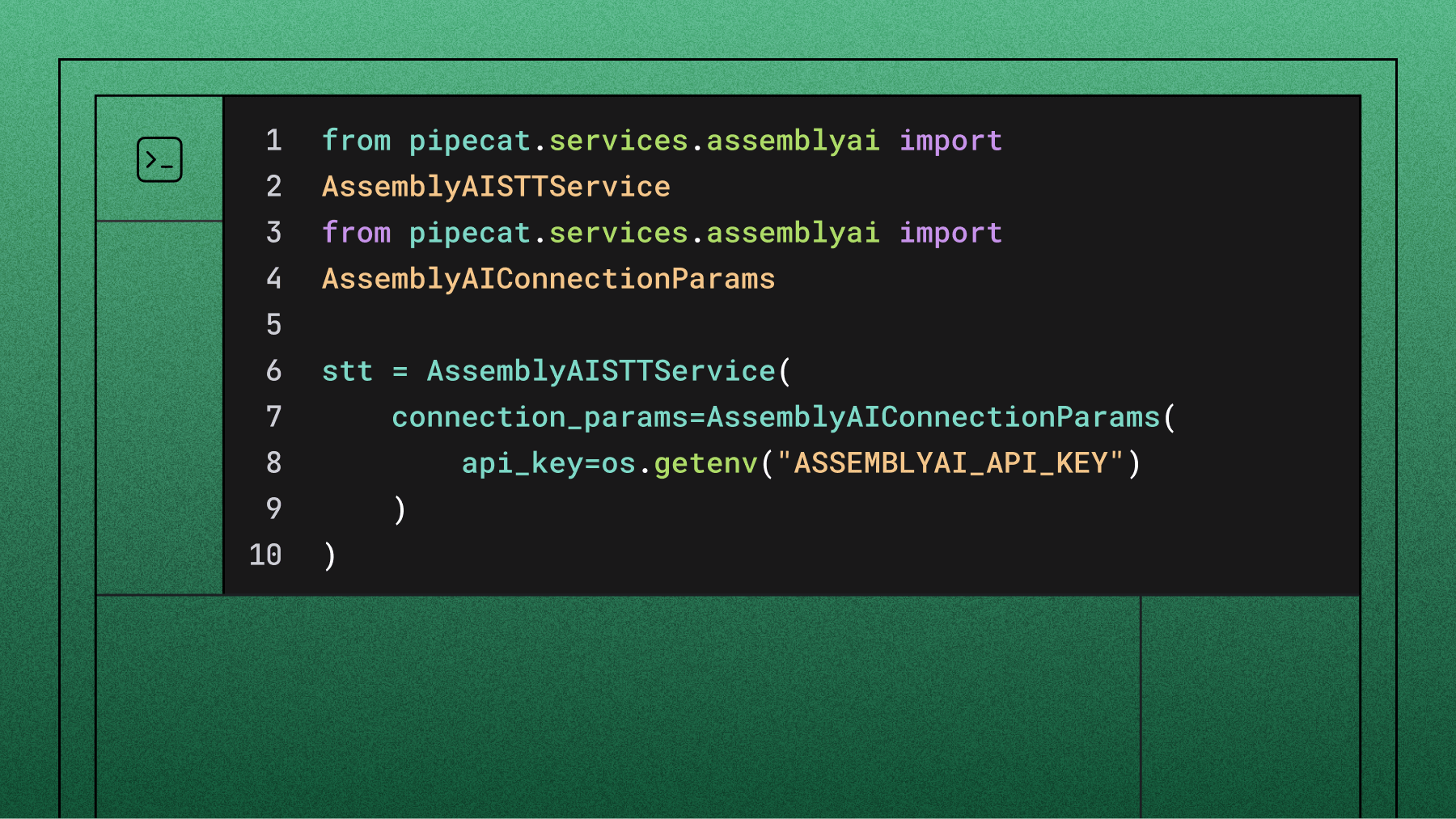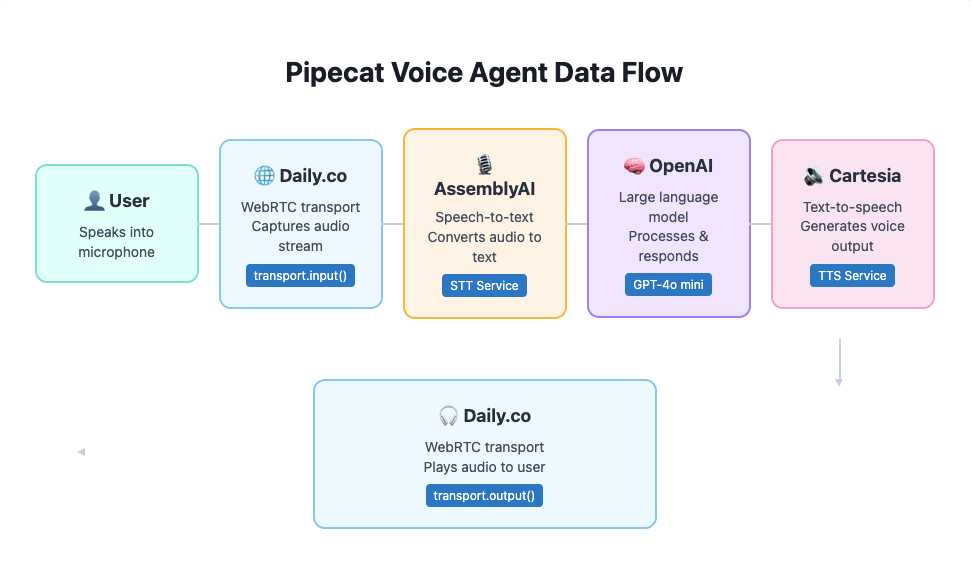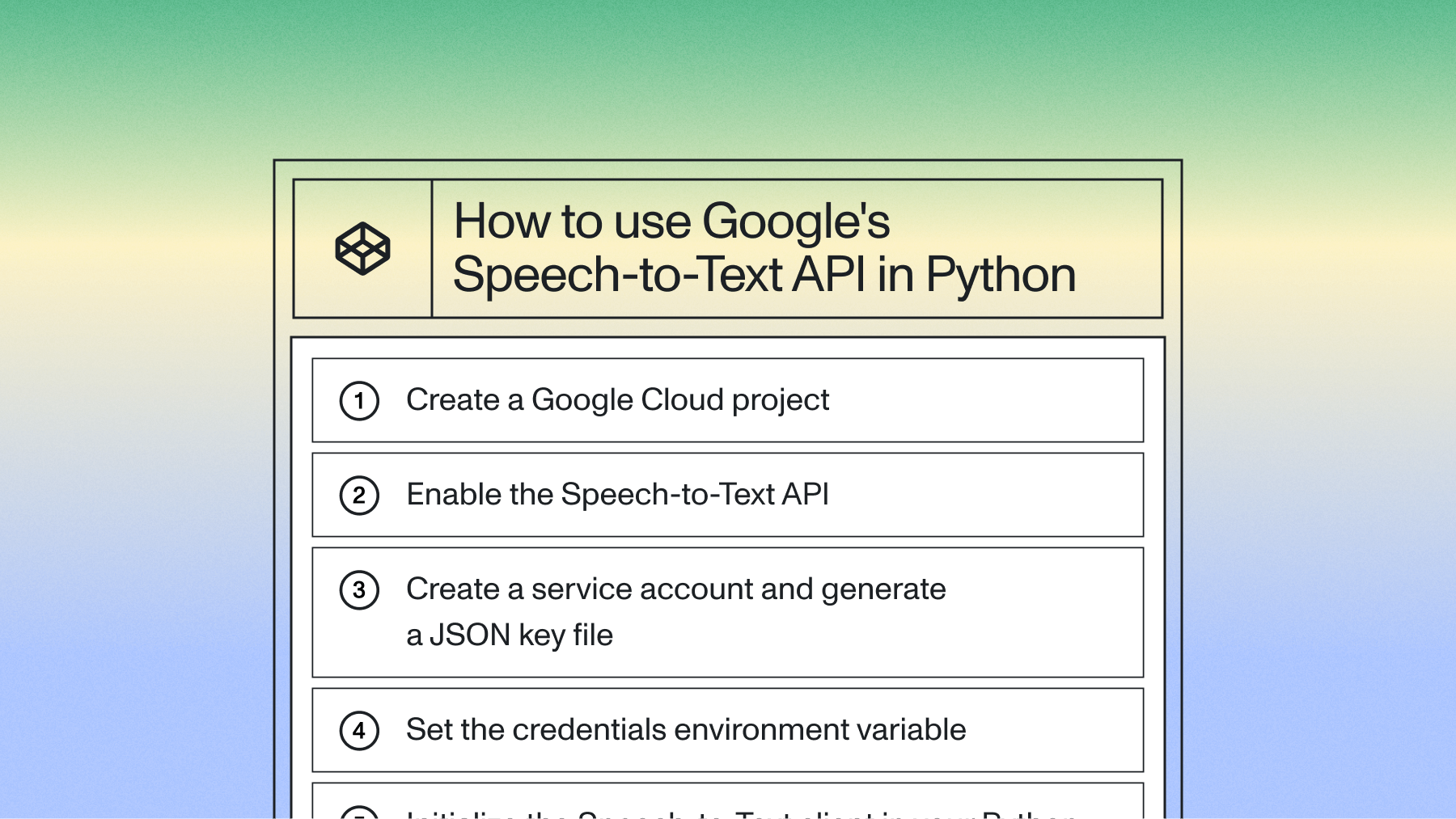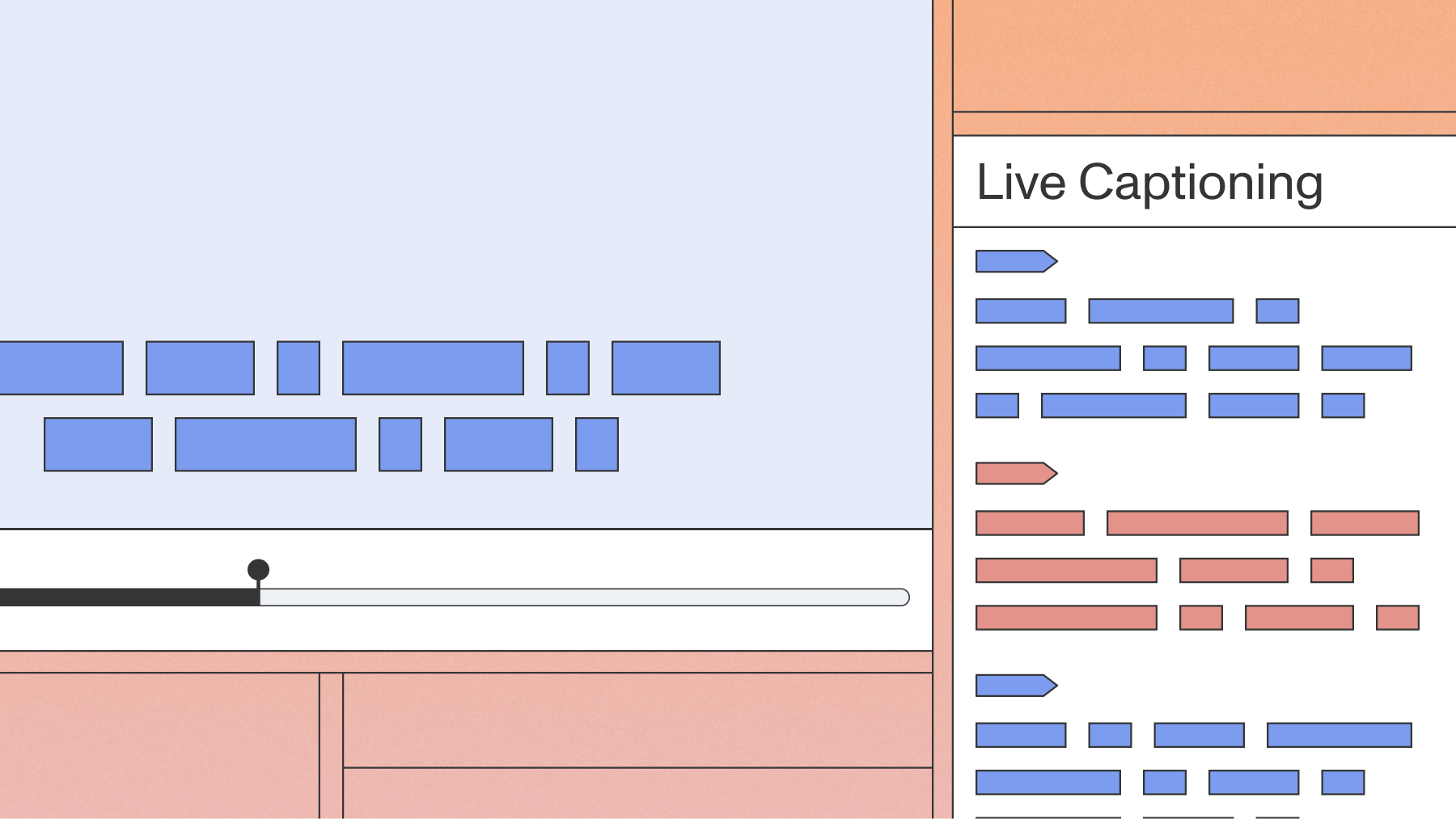How to build and deploy a voice agent using Pipecat and AssemblyAI
Ship voice AI agents with millisecond latency using Pipecat and AssemblyAI's Universal-Streaming. This complete tutorial walks you through setup, real-time transcription, testing, and cloud deployment.



Building a voice AI agent that responds in milliseconds used to require months of complex audio engineering. Today, you can ship production-ready voice agents in hours.
Modern voice agents require millisecond-level latency, accurate transcription even with background noise, and intelligent conversation management to feel natural. Building production-ready voice agents comes with specific challenges: ensuring accurate transcription of names and numbers, managing natural conversation flow without awkward interruptions, and maintaining low latency for real-time interactions.
In this tutorial, we'll build a production-ready voice agent that meets these requirements using Pipecat's orchestration framework, AssemblyAI's Universal-Streaming speech-to-text, OpenAI's reasoning capabilities, and Cartesia's natural voice synthesis. You'll learn how to create, test locally, and deploy a fully functional voice assistant to the cloud.
Here's what we're building: a conversational AI that understands spoken questions, processes them through a large language model, and responds with natural-sounding speech—all in real-time.
Understanding the architecture
Many modern voice agents use a cascading model approach where each specialized AI service handles one part of the conversation flow. Think of it as a production line where your voice passes through different stages:

- Speech Recognition: AssemblyAI's Universal-Streaming speech-to-text converts spoken words into text with intelligent turn detection
- Processing: Pipecat orchestrates the data flow between services
- Understanding: OpenAI's LLM interprets the text and generates responses
- Speech Synthesis: Cartesia transforms the response back into natural speech
- Delivery: Daily's WebRTC infrastructure ensures real-time communication
This modular architecture lets you swap components, optimize for specific use cases, and scale each service independently. Pipecat acts as the conductor, managing timing, interruptions, and the complex dance of real-time conversation.
When building production voice agents, consider the reliability requirements of your infrastructure. Services like AssemblyAI typically provide SLAs with specific uptime guarantees—important for business-critical applications.
Prerequisites and setup
Before we start building, ensure you have these tools installed:
- Python 3.10 or higher
- UV package manager for dependency management
- Docker Desktop for containerization
- A terminal with shell access
Important: Pipecat Cloud requires ARM64 architecture for deployment. If you're on an Intel Mac or Windows machine, you'll need to build multi-architecture Docker images.
Let's create our project:
mkdir pipecat-voice-agent && cd pipecat-voice-agent
uv tool install pipecatcloud
pcc auth login
pcc init
The pcc init command generates a pre-configured project structure. Open the project in your editor and update the requirements.txt file:
pipecat-ai[assemblyai,webrtc]
pipecatcloud
python-dotenv
Initialize your environment:
uv venv
uv pip install -r requirements.txt
Configuring API keys
Our voice agent requires API keys from four services. Here's where to find each one:
Copy env.example to .env and add your keys:
cp env.example .env
Your .env file should look like this:
ASSEMBLYAI_API_KEY=your_assemblyai_key_here
OPENAI_API_KEY=your_openai_key_here
CARTESIA_API_KEY=your_cartesia_key_here
DAILY_API_KEY=your_daily_key_here
Implementing AssemblyAI speech recognition
Now let's integrate AssemblyAI's Universal-Streaming speech-to-text service, which provides real-time transcription optimized for conversational AI. Open bot.py and add these imports at the top:
from pipecat.services.assemblyai import AssemblyAISTTService
from pipecat.services.assemblyai import
AssemblyAIConnectionParams
Initialize the STT service with your API key:
stt = AssemblyAISTTService(
connection_params=AssemblyAIConnectionParams(
api_key=os.getenv("ASSEMBLYAI_API_KEY")
)
)
For more natural conversations, you can customize the turn detection parameters:
# Tip: Customize turn detection for more natural conversations
stt = AssemblyAISTTService(
connection_params=AssemblyAIConnectionParams(
api_key=os.getenv("ASSEMBLYAI_API_KEY"),
end_of_turn_confidence_threshold=0.8, # Higher = wait
for more certainty
min_end_of_turn_silence_when_confident=300, # ms of
silence when confident
max_turn_silence=1000 # Maximum silence before forcing
turn end
)
)
The magic happens in the pipeline configuration. Pipecat processes audio through a series of services, and positioning matters. Add AssemblyAI after the context aggregator but before the LLM:
pipeline = Pipeline([
context_aggregator.user,
stt, # AssemblyAI processes audio here
llm,
tts,
transport.output,
context_aggregator.assistant,
])
To monitor transcriptions during development, let's add a transcript processor:
from pipecat.processors.transcript_processor import TranscriptProcessor
# Before creating the pipeline
transcript_processor = TranscriptProcessor()
# Update pipeline to include transcript monitoring
pipeline = Pipeline([
transport.input()
context_aggregator.user(),
stt,
transcript.user(),
llm,
tts,
transport.output(),
transcript_processor.assistant()
context_aggregator.assistant(),
])
# Add event handler
@transcript_processor.event_handler("on_transcript_update")
async def on_transcript_update(processor, data):
for msg in frame.messages:
print(f"{msg.role}: {msg.content}")
Testing locally
Before deploying, let's ensure everything works on your machine. The generated code includes a local testing flag:
env LOCAL_RUN=1 uv run bot.py
You should see the bot initialize and connect to Daily's WebRTC service. Speak into your microphone and watch the transcripts appear in your console. The agent should respond naturally to questions like "What is Pipecat?" or "Tell me about AI voice agents."
Common issues during local testing:
Building and deploying to the cloud
Pipecat Cloud simplifies deployment but requires specific configuration. First, update pcc-deploy.toml:
agent_name = "my-voice-agent"
image = "yourdockerhub/my-voice-agent:latest"
secret_set = "my-voice-agent-secrets"
Critical: Build your Docker image for ARM64 architecture:
docker build --platform=linux/arm64 -t my-voice-agent .
docker tag my-voice-agent yourdockerhub/my-voice-agent:latest
docker push yourdockerhub/my-voice-agent:latest
If you're on an x86 machine, use Docker's buildx for multi-platform builds:
docker buildx build --platform=linux/arm64 -t
yourdockerhub/my-voice-agent:latest --push .
Upload your secrets to Pipecat Cloud:
pcc secrets set my-voice-agent-secrets --file .env
Deploy your agent:
pcc deploy
Start your agent with Daily's interface:
pcc agent start my-voice-agent --use-daily --api-key
YOUR_PIPECAT_API_KEY
You'll receive a URL to interact with your deployed agent through a web interface.
Next steps
You've built a production-ready voice agent that combines best-in-class AI services. The complete code for this tutorial includes additional features and optimizations.
Consider enhancing your agent with:
- Multi-language support: Configure language detection and response
- Advanced turn detection: Fine-tune conversation flow parameters
- Speech Understanding: Add sentiment analysis or content moderation
Join the Pipecat Discord community for support and explore AssemblyAI's documentation for advanced speech recognition features.
Voice AI is rapidly evolving—what will you build next?
Lorem ipsum dolor sit amet, consectetur adipiscing elit, sed do eiusmod tempor incididunt ut labore et dolore magna aliqua. Ut enim ad minim veniam, quis nostrud exercitation ullamco laboris nisi ut aliquip ex ea commodo consequat. Duis aute irure dolor in reprehenderit in voluptate velit esse cillum dolore eu fugiat nulla pariatur.







